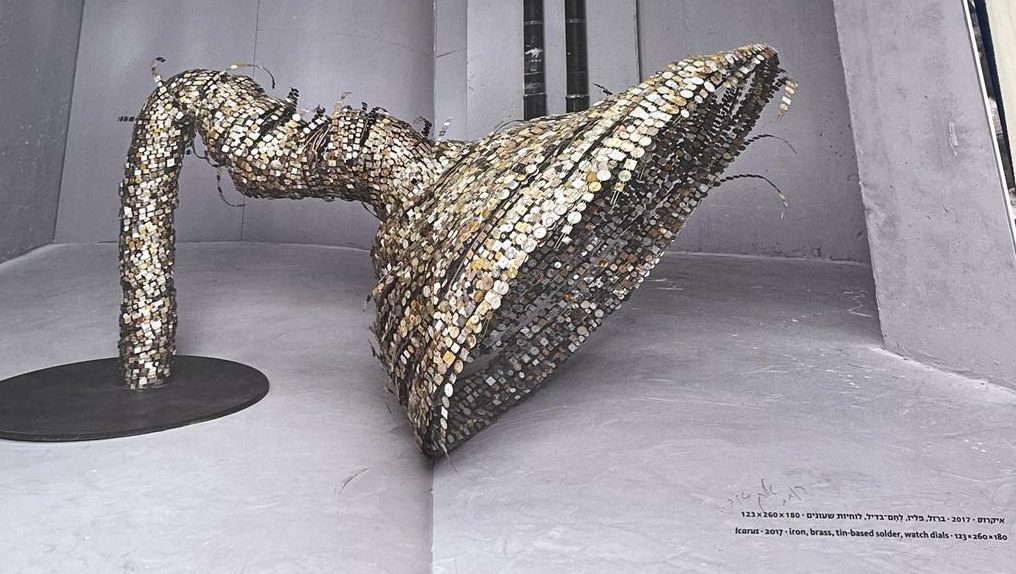Out of Exhibition – ”Icarus” (2017) – Doris Arkin
Presented as part of the solo exhibition “Chronicle”.
Must Know
Main structure and material:
The sculpture consists of a spiral iron construction, on which clocks soldered on thick copper wires are wound.
The old watches that have finished their duty came from different parts of the world, and were found by searching the Internet. There are approximately 11,000 watches in the creation, the watches are soldered to wires that carry them delicately and fragilely without damaging or puncturing them.
The work was built over 10 months by Arkin and her assistants.
The meaning of the work:
The clocks in the work were used in the past as a measuring tool through which people wore and measured the time of their lives, especially the events that accompanied them. This thought is a significant component of the sculptor’s work, for Arkin each of the clock faces represents a person, a personal story, a person and his world.
The desire to deal with the issue of time was born from the word Inexorable – to step forward decisively, without letting things stop. Arkin was looking for a visual expression that would reflect this feeling and that’s how she arrived at the image of the tornado – a force that drives everything that happens in its path. Time overwhelms us as human beings subjected to its forces through personal and historical events.
About the work process and the name of the work:
The Tornado sculpture was designed to be carried aloft, high above the heads of the spectators. The sculpture’s construction was designed by professionals to bear the weight of the thick metal wires and clock faces.
During the work, Arkin decided to add more clock faces than planned, and believed that her artistic desires were stronger than the properties of the material and the laws of physics, after adding more and more clock faces the sculpture collapsed during the work process to its current form.
The sculpture was named “Icarus”, a mythological figure, who wanted to fly close to the sun and believed he would succeed, built himself wings. But the sun melted his wings and he fell to the ground.
In order to honor the educational experience of meeting the material and as a result of the collapse event. He changed his planned structure from a body carried aloft to a sculpture supported on the floor.
More Info
Possible connections to the museum:
• As with any discussion around a modern work of art – it is recommended to initially ask the visitors “What do they see in the work?” and thus allow a discussion around the associations that arise.
• The motif of time – the Jewish motif of time – on the ground floor exhibits related to the motif of time; Shabbat, the cycle of the year, the prayers in the synagogues
• The motif of the individual versus the whole – many watches make up the whole like the Jewish story/identities is made up of the sum of its different parts
• Enigma around a work of art – ask the audience what thoughts you have about the work? Why do you think it is placed in a museum?
About the work from the Internet – Uzi Tzur, Culture and Literature, Haaretz:
The creation is a vortex that swirls around the suction neck of its formation and then swims and tilts on its side.
The vortex’s interior and outer circumference are made of thousands of wristwatch plates, two-sided chains of human time that are sometimes interrupted and deviate from the circular continuity. They are presented as stillnesses of dawnless beauty in its infinite versions. A minority of other shifts from circles.
This is a sculpture made of the tension between the individual and unique of each of its details that treasure the memory of its forgotten owner, and its sweeping general movement, the movement of oblivion. As a moving sunflower with the movement of the sun reflected in it, the time of the single day and the time between flowering and camila are created against the animating and killing eternity of the sun.

